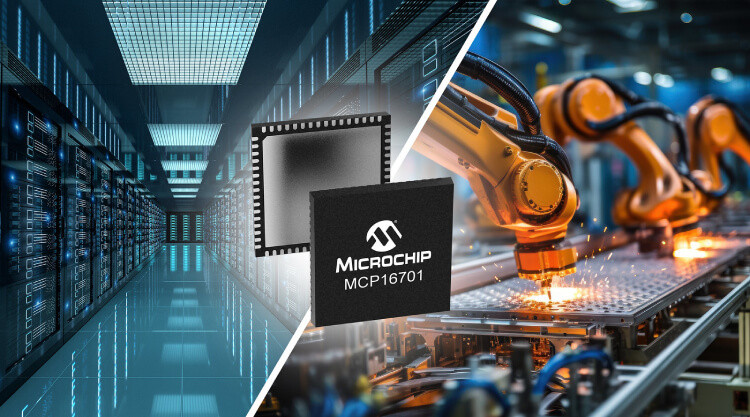Microchip MCP16701 PMIC for AI & Industrial Systems
15-04-2025 | By Matthew Walker

Key Thing to Know:
- Microchip’s MCP16701 PMIC integrates 8 buck converters, 4 LDOs, and a controller in a compact 8×8 mm package.
- Delivers up to 48% PCB area savings and 60% fewer components compared to discrete power solutions.
- Supports dynamic voltage adjustment and I2C communication for flexible, high-efficiency power delivery.
- Optimised for MPUs, FPGAs, and edge AI in industrial and embedded applications — fully compatible with Microchip’s PIC64-GX and PolarFire® platforms.
As artificial intelligence continues to proliferate across industries, from edge computing nodes to expansive data centre infrastructures, the demand for efficient and adaptable power management solutions is intensifying. Power systems must now accommodate increasingly complex architectures while maintaining compact footprints, robust thermal performance, and exceptional configurability. In this evolving landscape, hardware designers are under pressure to balance performance with efficiency — a challenge that is driving innovation in Power Management Integrated Circuits (PMICs).
Microchip Technology has stepped forward to address these demands with the launch of the MCP16701, a highly integrated PMIC introduced on April 10, 2025. Designed specifically for use in high-performance MPU and FPGA systems, the MCP16701 targets a range of cutting-edge applications spanning industrial computing, embedded systems, edge AI, and data centre platforms. With a compact form factor and advanced power configuration capabilities, this new device aims to streamline development while meeting the stringent requirements of next-generation designs.
“With the introduction of the MCP16701, Microchip is setting a new standard in PMIC technology by offering an unprecedented level of integration and flexibility,” said Rudy Jaramillo, Vice President of Microchip’s Analog Power and Interface Division. “This advanced PMIC is designed specifically for high-performance applications, enabling our customers to streamline their design process.”
A Closer Look – Features and Integration
At the heart of the MCP16701 is a deep commitment to integration — not just in terms of features, but in delivering tangible benefits to system designers. The PMIC incorporates eight 1.5A buck converters, which can be paralleled to deliver scalable current output based on application requirements. This modularity provides engineers with a high degree of flexibility when powering multi-rail systems, particularly in scenarios involving complex MPUs and FPGAs.
Complementing the buck converters are four internal Low Dropout Voltage Regulators (LDOs), each capable of delivering up to 300 mA, ideal for powering auxiliary rails and sensitive analogue circuitry. Additionally, an integrated controller enables the MCP16701 to drive external MOSFETs, further enhancing the device’s ability to support high-efficiency and high-power configurations.
This high level of integration translates directly into significant board-level advantages. Microchip reports that the MCP16701 can achieve a 48% reduction in PCB area compared to equivalent discrete solutions. Moreover, the solution reduces component count by up to 60%, minimising design complexity and improving reliability. Housed in a compact 8 mm × 8 mm VQFN package, the MCP16701 is particularly well-suited for space-constrained environments, where power density and layout efficiency are paramount.
Flexibility and System Efficiency
One of the defining strengths of the MCP16701 is its ability to adapt to the nuanced power requirements of high-performance systems. The device supports dynamic voltage output (Vout) adjustments in precise 12.5 mV or 25 mV increments, giving engineers fine-grain control over each rail’s voltage level. This capability is particularly valuable for optimising power delivery based on real-time processing demands, thermal conditions, or efficiency targets — essential in AI-driven workloads and compute-intensive applications.
To streamline system integration, the MCP16701 includes a built-in I2C communication interface, allowing seamless configuration and monitoring of the PMIC within embedded platforms. This digital interface ensures smoother coordination between the PMIC and host controllers, reducing the need for manual tuning and enhancing system reliability through programmable power control.
In terms of durability, the MCP16701 is built for rugged environments. It operates reliably across a broad junction temperature range of −40°C to +105°C, making it suitable for industrial, edge, and embedded deployments where thermal stability is critical.
Platform compatibility is another area where the MCP16701 excels. It has been designed to work natively with Microchip’s PIC64-GX MPU and PolarFire® FPGA platforms, enabling a fully optimised power architecture across the company’s ecosystem. Furthermore, the device complements Microchip’s existing portfolio of power management solutions, including the MCP16502 and MCP16501, offering design continuity and a scalable PMIC roadmap for developers.
Developer Support and Commercial Rollout
To accelerate adoption and ease of integration, Microchip supports the MCP16701 with the EV23P28A Evaluation Board, complete with a graphical user interface (GUI). This combination enables developers to rapidly prototype, configure, and fine-tune power delivery profiles, significantly reducing development time. The tooling is especially helpful in complex embedded systems where multiple power rails, load sequencing, and custom voltage requirements must be managed with precision.
On the commercial front, the MCP16701 is positioned as an accessible and scalable solution. It is priced at $3.00 per unit for orders of 10,000 units, aligning with budget-sensitive projects without compromising on performance or feature set. The device is available through MicrochipDirect as well as a global network of authorised distributors, ensuring wide availability for design teams around the world.
As engineers face growing demands for power density, thermal efficiency, and design adaptability, the MCP16701 stands out as a compact yet capable PMIC tailored for modern embedded systems. Its balance of integration, configurability, and platform alignment makes it an ideal choice for next-generation designs—particularly in applications where flexibility and performance must go hand in hand.

